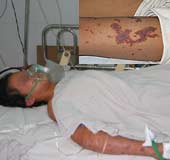|
|
|
Large Image: A patient infected with meningococcal disease being treated at the Tropical Diseases Hospital in Ho Chi Minh City. Small Image: The characteristic sign of the disease is a map-like rash. (Photo: B.S.T) |
One day before hospitalization, 12-year-old N.P.T, residing in Ward 12, District 6, Ho Chi Minh City, suddenly had a high fever and vomiting. That night, the child complained of fatigue and developed some rashes on the chest. At 6:15 AM on June 6, T. was brought to the emergency department at Children’s Hospital 1 in a state of shock, cardiovascular collapse, cold extremities, and a rash (hemorrhagic rash) on the chest. Doctors diagnosed the patient with septicemia and initiated intensive treatment. However, due to the severity of the illness and rapid progression (by noon, the rash had spread all over the body), T. unfortunately passed away by 2 PM the same day. Test results indicated that the causative agent was Neisseria meningitidis.
Various Forms of the Disease from Mild to Severe
According to statistics from the Ho Chi Minh City Center for Disease Control, since the beginning of the year, there have been 9 reported cases of meningococcal disease requiring hospitalization, with 4 fatalities (2 adults and 2 children). Compared to recent years, the number of meningococcal cases requiring hospitalization has significantly increased this year. Dr. Nguyễn Đắc Thọ, Deputy Director of the Center for Disease Control, attributes this rise to the cyclical nature of infectious diseases that typically occurs every 5 to 7 years, suggesting that this year may signify a resurgence of meningococcal disease.
Dr. Trương Hữu Khanh, Head of the Infectious Diseases Department at Children’s Hospital 1, stated that while meningococcal disease has existed for a long time, it has become quite rare in recent years. The disease is caused by various serogroups of Neisseria meningitidis, including A, B, C, W, and Y. When infected with this bacterium, a patient may exhibit a range of clinical symptoms from mild to severe. Initial symptoms can include sore throat, meningitis, septicemia, and in the most severe cases, fulminant septicemia. Mild cases of sore throat may resemble typical throat infections, presenting with sore throat, cough, and fever, often resolving on their own or with antibiotics. In more severe cases, the bacteria can invade the brain, causing meningitis, leading to symptoms such as headache, vomiting, high fever, stiff neck, seizures, and coma. Some cases may also present with dark hemorrhagic rashes on the skin.
80% Mortality Rate in Fulminant Cases
Experts indicate that the most dangerous aspect of meningococcal infection is that the bacteria from the throat can enter the bloodstream, causing septicemia. This condition is divided into two types: acute septicemia and fulminant septicemia. Symptoms of acute septicemia usually last for 1 to 2 days after a high fever, accompanied by scattered hemorrhagic rashes throughout the body. In contrast, fulminant septicemia presents with high fever, vomiting, lethargy, and a cyanotic appearance within 12 hours, with rashes spreading very rapidly, often covering the entire body within 6 hours. The bacteria can cause necrosis of fingers and toes, leading to digital loss or necrosis of skin areas (which may later require surgical debridement leaving scars). These cases typically have an 80% mortality rate.
Rapid Transmission of the Disease
Dr. Khanh noted that Neisseria meningitidis spreads quickly through respiratory droplets, especially in crowded and unsanitary environments. Recently, vaccines have become available worldwide for 4 serogroups: A, C, W, and Y. However, in Vietnam, only vaccines for serogroups A and C are currently available. Therefore, the most effective prevention method remains maintaining oral hygiene and a clean environment. When experiencing symptoms of throat infection, it is crucial to seek immediate treatment to prevent the bacteria from attacking other areas. Family members of infected patients and those in close contact should take ciprofloxacin as a preventive measure (medication provided by the Center for Disease Control).
|
Outbreaks Have Emerged! Dr. Nguyễn Đắc Thọ, Deputy Director of the Ho Chi Minh City Center for Disease Control, reported that small outbreaks of meningococcal disease have recently been detected in the city. When severe cases are identified in the community (it is challenging to detect mild cases due to symptoms resembling ordinary throat infections), the Center for Disease Control will implement environmental controls to prevent further spread and development into severe cases. The best preventive measures for the public include enhanced personal hygiene, environmental cleanliness, and avoiding contact with sources of infection. Surveys of meningococcal cases reveal that most patients live in overcrowded conditions. For instance, three weeks ago, the Tropical Diseases Hospital admitted a 16-year-old female patient working in District 5 of Ho Chi Minh City, diagnosed with meningococcal septicemia. The patient reported living in a room of about 25 square meters shared with… 20 people! |
Thùy Dương



















































